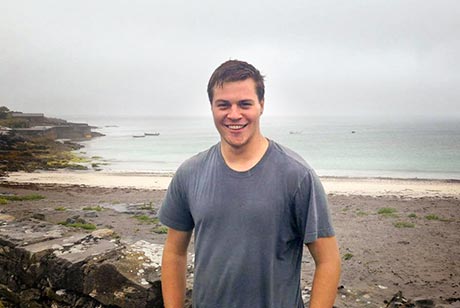Rawlings Scholars display an array of research
By Blaine Friedlander


Examining everything from social movements to Facebook addiction to slowing Alzheimer’s disease, more than 50 graduating seniors showcased their research prowess at the 2015 Senior Expo for Hunter R. Rawlings III Cornell Presidential Research Scholars April 16.
The Rawlings scholars program, for students with strong academic potential and intellectual curiosity, provides significant research support throughout their undergraduate careers. About 200 students are supported each year.
Samples of the Rawlings scholars’ work:
Studying coastal flooding and erosion in Ireland, Bryan Finneran ’15, Agriculture and Life Sciences, found that the relative severity of recent costal storms indicates that effects due to climate change are underway and threaten natural coastal habitats, Ireland’s tourism industry and the country’s coastal infrastructure.
Through focusing on the work of the Mississippi Freedom Labor Union (MFLU), founded in 1965, Rachel Harmon ’15, ILR School, explored the methods and outcomes of the economic justice organizing component of Mississippi’s black freedom struggle. Examining federal welfare and labor policy and local white resistance efforts, Harmon created a framework to assess the impact of social movements and organizations that may not necessarily have achieved their stated objectives.
In another study, Emma Gerstenzang ’15, Arts and Sciences, examined health attitudes and behaviors of individuals in the Mississippi Delta. The area has extreme health inequality, but religious beliefs were found to have a significant impact on attitudes toward health.
Galen Guevara ’15, ILR, studied how salary situations differ for players in Major League Baseball. By using advanced metrics and regression models, Guevara quantified the value of a win in the free agent and arbitration markets.
Shelby Rokito ’15, Agriculture and Life Sciences, investigated constant Facebook use among undergraduate students. Using custom-built software to capture in-the-moment data, Rokito found need gratification predicted how frequently students returned to Facebook, as well as how long they lingered on a Facebook session. The strength of a student’s social media habit predicted the number of times he or she accessed Facebook per day.
Investigating possible to solutions to help Alzheimer’s disease patients, Iryna Ivasyk ’15, Engineering, studied how specific antibodies could deplete leukocytes in the blood stream. Ivasyk found leukocytes decreased substantially, which could lead to a short-term improvement in cerebral blood flow and a possible therapeutic medicine for the disease.
The giants of retail – Target and Wal-Mart – have amassed power and wealth at a dizzying pace, explains Jessica Stewart ’15, ILR. Meanwhile, labor’s power has dwindled as more Americans work at big-box retailers than well-paid unionized manufacturing jobs. Stewart showed how Target and Wal-Mart – both companies using the same business practices – impeded unionization and accelerated the degradation of the American paycheck.
Unlike prescription drugs, vitamins, minerals, botanicals and other dietary supplements don’t need Food and Drug Administration approval to be sold. Rachel Saltzman ’15, Agriculture and Life Sciences, analyzed print and television advertisements to show how nonpharmaceutical companies may be providing consumers with false information by making claims that are unsubstantiated.
Clay Lifflander ’84, MBA ’86, founder of Hudson River Capital Partners, underwrote the event.
Media Contact
Get Cornell news delivered right to your inbox.
Subscribe